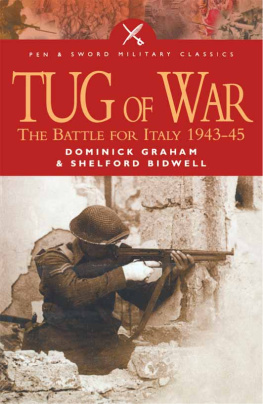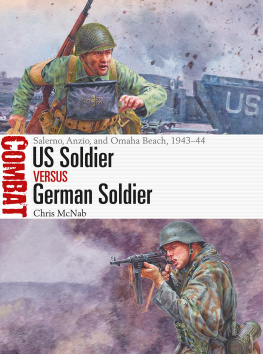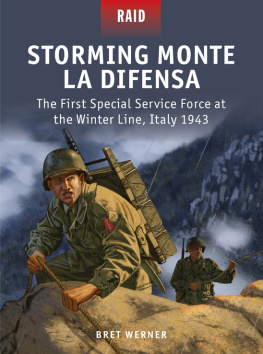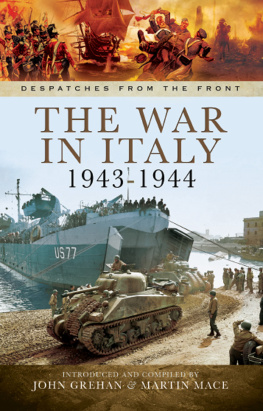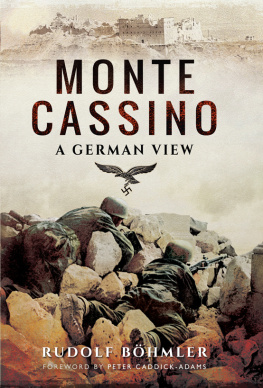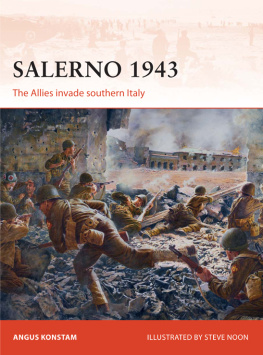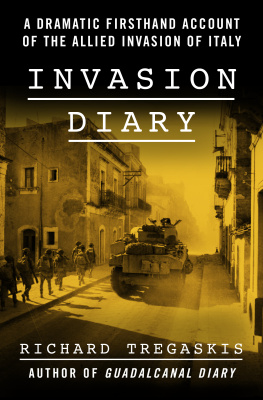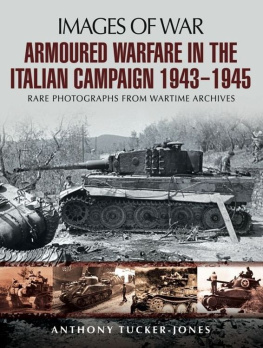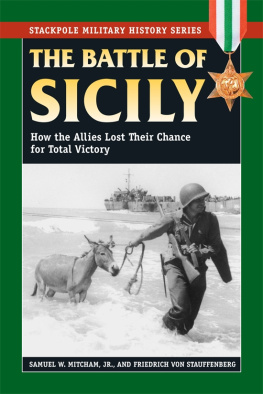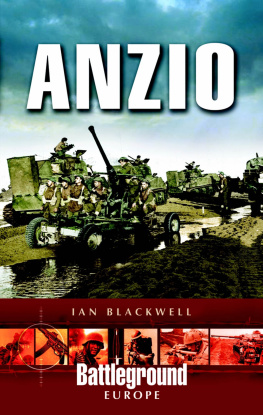Tug of War
BY SHELFORD BIDWELL
Gunners at War: A Tactical Study of the Royal Artillery in the Twentieth Century
Swords for Hire: European Mercenaries in Eighteenth-Century India
Modern Warfare: A Study of Men, Weapons and Theories
The Royal Horse Artillery
The Womens Royal Army Corps
The Chindit War: The Campaign in Burma, 1944
Artillery of the World (Ed.)
World War 3 (Ed.)
BY DOMINICK GRAHAM
Cassino
British Government and American Defence, 174856
No Substitute for Peace (With Maurice Tugwell and David Charters)
BIDWELL and GRAHAM
Fire-Power: British Army Weapons and Theories of War, 19041945
Tug of War
The battle for Italy, 19431945
Dominick Graham
and
Shelford Bidwell
PEN & SWORD MILITARY CLASSICS
The extract from Rural Raid by Denton Welch which appears on page 191 is reproduced with
the kind permission of David Highham Associates and is taken from The Terrible Rain: The War
Poets 19391945 published by Methuen.
First published in 1986 by Hodder & Stoughton.
Published in 2004, in this format, by
PEN & SWORD MILITARY CLASSICS
an imprint of
Pen & Sword Books Limited
47 Church Street
Barnsley
S. Yorkshire
S70 2AS
Copyright Dominick Graham and Shelford Bidwell, 1986, 2004
ISBN 1 84415 098 4
The right of Dominick Graham and Shelford Bidwell to be identified as
Authors of this Work has been asserted by him in accordance with the
Copyright, Designs and Patents Act 1988.
A CIP record for this book
is available from the British Library.
All rights reserved. No part of this book may be reproduced or
transmitted in any form or by any means, electronic or mechanical
including photocopying, recording or by any information storage a
nd retrieval system, without permission from the Publisher in writing.
Printed and bound in Great Britain by
CPI UK
For a complete list of Pen & Sword titles please contact:
PEN & SWORD BOOKS LIMITED
47 Church Street, Barnsley, South Yorkshire, S70 2AS, England.
E-mail: enquiries@pen-and-sword.co.uk
Website: www.pen-and-sword.co.uk
We are greatly indebted to our fellow historians and other distinguished persons for help we received when working on this study of the Italian campaign. As they are variously located in Canada, England, France, New Zealand and the United States and we consulted them separately, we consider it appropriate to express our gratitude separately.
Bidwell thanks Lieutenant-General Sir Ian Jacob for an authoritative view of the problems of command and commanders at the highest level; General Sir Frank Simpson and Major-General Eric Sixsmith for answering questions on organisational matters; Major-General Adam Block, Colonel John Mennell, Lieutenant-Colonel P. S. Turner and Michael Glover for their impressions of events at the operational level, together with their perceptions of some commanders and national contingents. He received valuable advice and information from the military historians Correlli Barnett, Carlo DEste, Nigel Hamilton, the late Ronald Lewin and, in particular, from John Terraine, with whom he has long enjoyed a profitable dialogue. Roy Smith provided useful information concerning air support, and Michael Wasilewsky indicated sources to consult on the Polish Forces. He also consulted W. McAndrew (see under Graham).
To these names must be added those of J. Harding, Historical Branch (Army), Ministry of Defence; Patricia Methven, The Liddell Hart Centre for Military Archives, Kings College, London; Air Commodore H. A. Probert and Group Captain T. Flanagan, Royal Air Force Historical Section; Roderick Suddaby, the Imperial War Museum, and Richard Tubb, Librarian, the Royal United Services Institute for Defence Studies, together with the staffs of those establishments.
We are both especially indebted to Lieutenant-Colonel H. R. D. Emery, The French Embassy, London, for his help, and to Monsieur le Gnral Delmas, Chef de Service Historique for the gift of three volumes on the French participation in the Italian campaign.
Graham thanks Dr Alec Douglas and his staff at the Directorate of History, National Defence Force HQ, Ottawa and in particular Brereton Greenhous and William McAndrew for showing him material concerning their tour of the Gothic Line; Justice Sir John White for recalling events at General Freybergs HQ during the Battles of Cassino; the staff of the National Archives in Wellington, New Zealand; Martin Blumenson for conversations concerning Mark Clark and the Italian campaign, and his kindness in allowing him to see his biography of Mark Clark in manuscript; Richard Kohn and the staff at the Office of Air Force History for their kindness; and Richard Sommers at the Archives of the Military History Institute, Carlisle Barracks, Pennsylvania for the trouble he took to find relevant documents. He is immensely grateful to Nick Straker, whose research in the British Cabinet Offices in 1970 laid the foundation for our study of the battles of Salerno, Cassino, Anzio and the Gothic Line. To these names he adds those of the late John Sherman, Robert Tooley, Valerie Graham, Pat Harahan and David Zimmerman for their comments on draft chapters; and of James Parton for providing information about Ira C. Eakers part in the operations at Cassino, and also The History of the Mediterranean Air Forces, which he wrote in the spring of 1945.
We wish to emphasise that though we researched separately we are both equally and jointly grateful to all the above.
Ion Trewin, now Editorial Director of our publishers, Hodder & Stoughton, provided encouragement, advice and criticism which has resulted, we hope, in a greatly improved and enlarged text. This was polished by the meticulous editing of Christine Medcalf, who also coordinated the sometimes mutually conflicting views of the co-authors with skill and tact. We thank them both.
Alec Spark drew the maps, adroitly compressing the essential information into a limited space without loss of clarity.
Jean Walter, whose flair as a sub-editor and reader is equal to her accomplishments as a copy-typist of the books of many authors, decrypted an often chaotic typescript to provide a text fit for the publisher.
Our last and warmest expression of thanks is to our wives, who provided the moral and logistic support on which we depended as draft chapters and mutual criticisms winged their way back and forth across the Atlantic.
In conclusion, we state formally that the responsibility for all expressions of opinion advanced by us and for errors of fact is ours alone.
CONTENTS
Acknowledgements
The Imperial War Museum
Bundesarchiv
Public Archive, Canada
No-one starts a war or, rather, no-one in his senses should do so without being clear in his mind what he intends to achieve by that war and how he intends to conduct it.
Karl von Clausewitz
At 4.30 a.m. on September 3, 1943 the citizens of Reggio Calabria, at the tip of Italys toe, were awakened by a thunderous bombardment. Cascades of aerial bombs, hundreds of shells from warships and 400 tons of ammunition fired by field artillery on the western shore of the Straits of Messina fell on the beaches north of the town. Then, as the barrage lifted, three brigades of Canadian and British infantry disembarked from landing craft and waded ashore, to claim the honour of being the first Allied troops to set foot on the soil of Nazi-dominated Europe with the firm intention of staying there. Their passage had neither been molested by the legendary monster Scylla, whose habit it was to snatch seamen from the decks of passing ships and devour them, nor troubled by the whirlpools of Charybdis. Nor was there any interference from a more real danger, the 26th Panzer and the 29th Panzer Grenadier Divisions defending the eastern shore of the narrows. Their commanders, alerted by the preliminary bombardment of their gun positions, and following their orders, prudently had faded away into the mountainous interior of Calabria two days before, leaving their Italian comrades to offer what resistance they could, which was little. A few long-range guns opened fire from far inland, to be rapidly silenced by Allied air attack. The Italians in the coastal defences surrendered with alacrity, even lending willing hands to help unload the landing craft.

